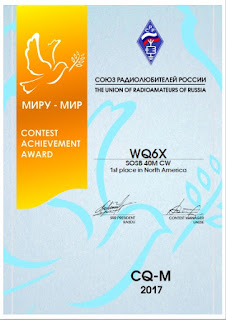Since installing a new fiber-optic microwave access tower @ NX6T (in Fallbrook), "NashVille" has become more reliably accessible for remote operators (such as WQ6X & N6CY). This last weekend gave us the opportunity to thoroughly test the remote access configuration. Otherwise, we ran a standard configuration of K3 radios into either an ACOM 2000a amplifier (STN-1) or an Expert
2-KL amplifier (STN-2), both into a 160 meter inverted vee with a 70' apex.
 |
| NIR-12 + 752 filters |
For this contest event it was a radio swap @ STN-1 that was initially our critical issue, delaying N6KI's initial
start until 02:00z. (Dennis quickly made up for lost time with a couple
of 70+ QSO hours.)
On my remote end of the operation, I got to play around with a JPS NIR-12 "Noise and Interference Reducer" along with a pair of MFJ-752 audio filters, all to process the laptop's
IP-sound audio.
Once properly adjusted, the 752's gave me a partial stereo-CW effect; higher pitched signals appeared in the left ear and lower pitched signals ended up on the right. The NIR-12 introduced tighter audio bandwidth for the left ear.
 |
| NX6T remotely during dinner |
Friday evening, by the time I took
over the "dinner shift" (@04:00z) Dennis had put over 200 QSOs
into the 160 log.
My 1st QSO of the evening was with none other than N6GEO; someone I have run numerous multi-OP events with over the last 9 years.
I was literally putting on the headphones while sending George
the exchange for QSO #211.
 While QRN was a mild annoyance for this 160 weekend, the more difficult phenomenon was quick fading; specif-ically with weak signals. Altho the contest requires we
While QRN was a mild annoyance for this 160 weekend, the more difficult phenomenon was quick fading; specif-ically with weak signals. Altho the contest requires we send "599", we ONLY need to send it once. I set up
FKey-6 to ask for ONLY the QTH, yet stations
robotically send 599+QTH.
Unfortunately, with quick fading, signals often dropped out after the "599" obliterating the 2-or-3 charter abbreviation.
I remind people of this EVERY contest and yet they STILL send me unnecessary information and are perplexed why
I keep asking for a QTH repeat . The solution is simple: send ONLY the QTH (w/o 599); even with quick-fading
I will get it the first time and we can BOTH move on.
Propagation-wise, on Saturday, 160 meters opened in
San Diego at 23:00z, but only to California. At 00:50z,
the Southeast quickly flooded in followed by W8 & VE3.
By 01:40, NP2J was in the log. Openings this early to
the Left Coast are usually unheard of, making this 160
contest a delightful surprise.
As I usually do, for this weekend, most of my op-time was during the "dinner" hour (04:00z - 06:00z) and then the "wee hours" of the morning (usually after 09:00z - 10:00z). Luckily, a Christmas present of Popcornopolis caramel corn kept me fueled in the operator's chair during these sleepy hours, along with some super strength KONA coffee.
This weekend was another manifestation of my oft-repeated complaint regarding operators who score a QSO on my run frequency and then shift down barely 200hz to call "CQ Test". Has it ever occurred to them that most stations are running 500hz filters at best; even with a
250hz filter, their 200hz shift is STILL within filter skirts
and annoyingly audible.
My solution is to shift the VFO down 200hz and send "QRL QSY" several times working back up to the run frequency during the final QRL/QSY. In most cases, operators get the message and put more "distance" between themselves and "thou".
One station was so annoyed that I asked him to move
that he zero-beat my run frequency and sent patches of random dits/dahs atop of weak stations calling in, requiring numerous repeats; eventually he got bored with this and moved on.
Considering that the inverted vee at Nashville is hardly favoring Asia, I was delighted to work several JA stations both Saturday & Sunday morning. While BG7 & BG5 stations appeared in the bandmap, they unfortunately were not audible @ NX6T.
It was amazing how many DUP callers there were, indicating that nearly everyone was running out of new QSOs to make. After the contest, in looking at the 3830 Scores website I noticed that most of the top scores were all European stations. We were overjoyed to work 14 DXCC entities while they were bummed that their DX count was only 85 (just missing DXCC) - it certainly is all relative.
When it was all over we entered 834 legitimate QSOs (460 remotely) into the log for 145k contest points; not bad for an inverted VEE @ 70'. While we were at the bottom of the North American heap (E. Coast stations have a definite advantage over the Left Coast) it would seem that we did take a
1st place for W6 (California).
Did YOU work the CQ 160 meter CW contest?
Is NX6T in YOUR log?





















